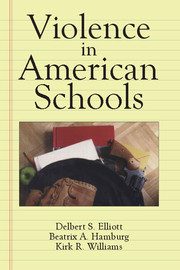Book contents
- Frontmatter
- Contents
- Acknowledgments
- List of contributors
- I INTRODUCTION
- II UNDERSTANDING CHILD AND YOUTH VIOLENCE
- III SCHOOL-BASED INTERVENTIONS
- 6 Preventing Firearm Violence in and Around Schools
- 7 Reducing Violence Through the Schools
- 8 Evaluations of School-Based Violence Prevention Programs
- 9 Safe School Planning
- IV COMMUNITY-BASED INTERVENTIONS
- V CONCLUSIONS
- Author index
- Subject index
7 - Reducing Violence Through the Schools
from III - SCHOOL-BASED INTERVENTIONS
Published online by Cambridge University Press: 12 October 2018
- Frontmatter
- Contents
- Acknowledgments
- List of contributors
- I INTRODUCTION
- II UNDERSTANDING CHILD AND YOUTH VIOLENCE
- III SCHOOL-BASED INTERVENTIONS
- 6 Preventing Firearm Violence in and Around Schools
- 7 Reducing Violence Through the Schools
- 8 Evaluations of School-Based Violence Prevention Programs
- 9 Safe School Planning
- IV COMMUNITY-BASED INTERVENTIONS
- V CONCLUSIONS
- Author index
- Subject index
Summary
Introduction
Concern about adolescent violence is not new, nor is a focus on the role of schools in reducing violence (McPartland & McDill, 1977). As a society, we are quick to jump to solutions: a violence prevention curriculum for the classroom, a conflict resolution team for the hallways and school grounds, hallway monitors and hallway patrols, visitor sign-ins, metal detectors, or school uniforms. In our view, these are partial solutions that miss a fundamental fact: Effective schools prevent violence. Schools that promote prosocial, cooperative behavior, and a culture of learning, are central to preventing violence.
To design effective strategies for violence prevention in schools, one needs to use what one knows about where violence comes from: what factors contribute to the risk of violent behavior, and what factors protect children against becoming either violent offenders or victims of violence. One also needs to use research evidence regarding effective interventions that reduce risk for and enhance protection against violence.
Given the multiplicity of risk and protective factors for violence, preventive interventions should be guided by theory that suggests the causal mechanisms that link these factors to future violence. Theory plays a critical role in specifying how different risk and protective factors interrelate, and how and when they should be addressed through intervention (Kazdin, 1990).
Risk Factors for Violence
Extensive research has identified risk factors for violence across the life span (American Psychological Association, 1993; Brewer, Hawkins, Catalano, & Neckerman, 1995; Reiss & Roth, 1993; Sampson & Lauritsen, 1994). Individual and environmental factors interact to promote or inhibit violent behavior. Exposure to multiple risk factors during childhood appears to increase significantly the likelihood of later violence (Huizinga, Loeber, & Thornberry, 1995).
From conception to age six, risk factors for violence include perinatal difficulties (e.g., preterm delivery, low birthweight, and anoxia or oxygen deprivation), physical trauma to infants, minor physical abnormalities and brain damage (e.g., from infectious disease; traumatic head injury; or exposure to toxins such as heavy metals, alcohol, tobacco, or cocaine) (Brennan, Mednick, & Kandel, 1991; Michaud, Rivara, Jaffe, Fay, & Dailey, 1993). Some of these factors may impair reasoning and impulse control in the developing child, leading both to later academic and behavioral difficulties in school and to increased risk of violent behavior in stressful situations.
- Type
- Chapter
- Information
- Violence in American SchoolsA New Perspective, pp. 188 - 216Publisher: Cambridge University PressPrint publication year: 1998
- 52
- Cited by

